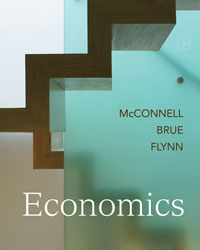Economics (McConnell), 18th EditionChapter 34:
Financial EconomicsWorked Problems <a onClick="window.open('/olcweb/cgi/pluginpop.cgi?it=jpg::::/sites/dl/free/0025694212/384254/wp_icon_20.jpg','popWin', 'width=NaN,height=NaN,resizable,scrollbars');" href="#"><img valign="absmiddle" height="16" width="16" border="0" src="/olcweb/styles/shared/linkicons/image.gif"> (19.0K)</a>
Problem 34.1 - Present value <a onClick="window.open('/olcweb/cgi/pluginpop.cgi?it=jpg::::/sites/dl/free/0025694212/384254/wp_icon_20.jpg','popWin', 'width=NaN,height=NaN,resizable,scrollbars');" href="#"><img valign="absmiddle" height="16" width="16" border="0" src="/olcweb/styles/shared/linkicons/image.gif"> (19.0K)</a>
Problem 34.1 - Present value
Problem: Suppose you invest $1,000 in a financial asset earning an annual interest rate of 6%. - How much interest will you earn after one year? How much money will be available to you (principal and interest) at the end of one year?
- If the money is allowed to compound annually at 6%, how much money will be available at the end of 2 years? 5 years?
- Suppose you have the opportunity to purchase a risk-free asset that will return $1,000 one year from now. If the risk-free interest rate is currently 5%, what is the present value of this asset?
- Alternatively, suppose the risk-free asset will return $1,000 two years from now. Still assuming a risk-free interest rate of 5%, what is the present value of this asset?
- You are considering purchasing a risk-free asset that will return $1,000 at the end of one year, another $1,000 at the end of the second year, and another $1,000 at the end of the third year. What is present value of this asset if the risk-free interest rate is 5%?
- Why does the present value of an asset tell you the greatest amount you should pay for the asset?
| Answer: - At a rate of 6%, an investment of $1,000 will earn .06 x $1,000 = $60 in interest. Added onto the original $1,000, a total of $1,060 will be available. This total can be computed alternately using the formula $1,000 x (1 + .06) = $1,060.
- The $1,060 available at the end of the first year will earn .06 x $1,060 = $63.60 in additional interest over the second year. The total available at the end of the second year is then $1,060 +$63.60 = $1,123.60. Alternatively, $1,123.60 = $1,000 x (1.06)2, or $1,000 x 1.06 x 1.06. At the end of 5 years, the total available will be $1,000 x (1.06)5 = $1,000 x 1.06 x 1.06 x 1.06 x 1.06 x 1.06 = $1,338.23.
- At 5%, the present value of $1,000 one year from now is $1,000 / (1.05) = $952.38.
- The present value is $1,000 / (1.05)2 = $907.03.
- As determined in parts c and d, the present value of $1,000 received at the end of one year is $952.38, while the present value of $1,000 received at the end of two years is $907.03. Similarly, the present value of $1,000 received at the end of three years is $1,000 / (1.05)3 = $863.84. The present value of a risk-free asset returning $1,000 at the end of each of the first three years is the sum: $952.38 + $907.03 + $863.84 = $2,723.25.
- Paying any amount greater than the present value would imply receiving a lower rate of return than could be obtained by investing in the risk-free asset.
|
 |  |





